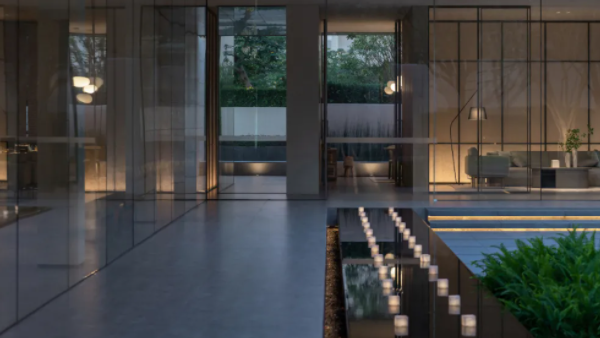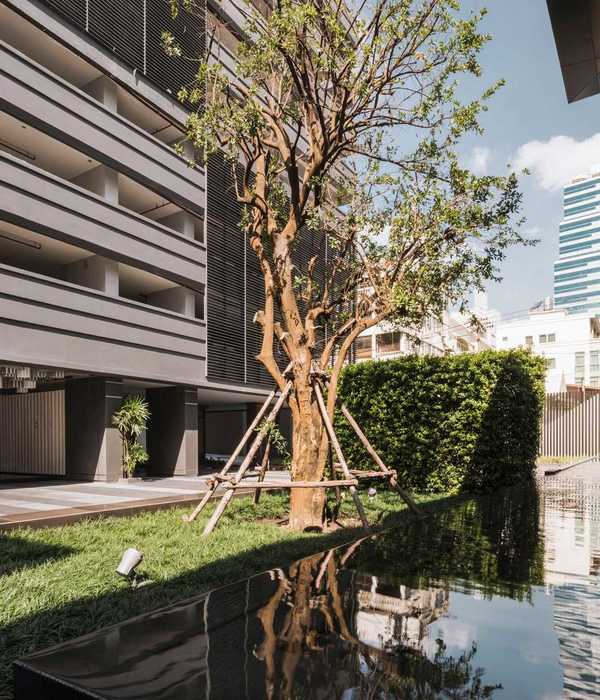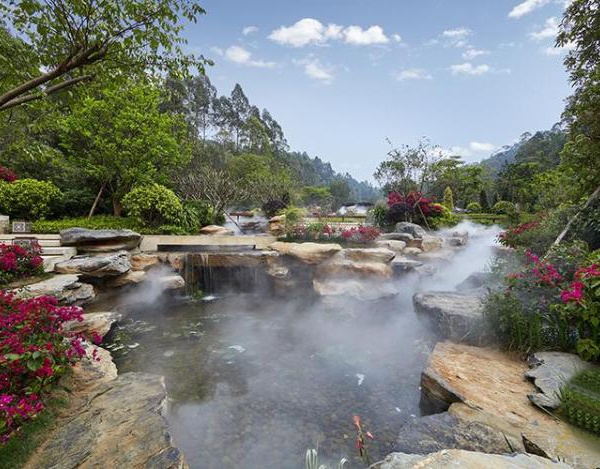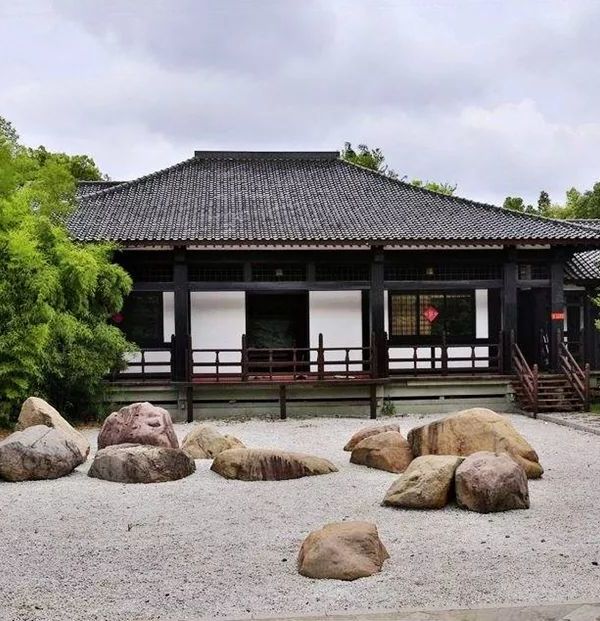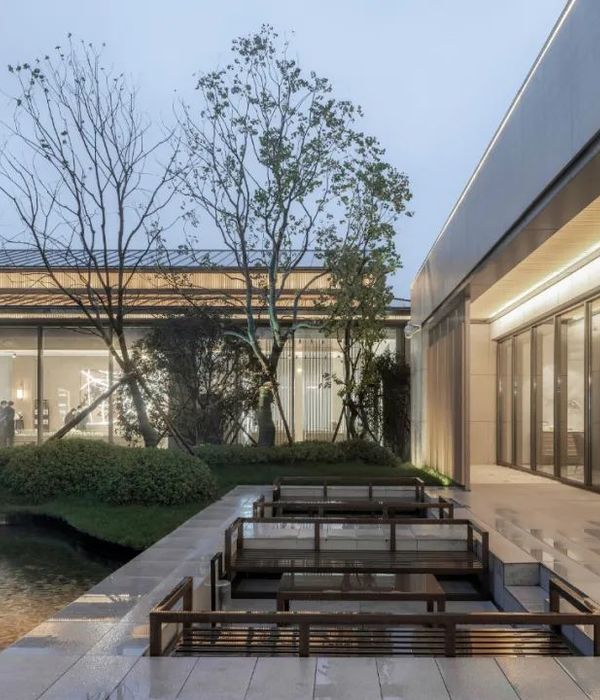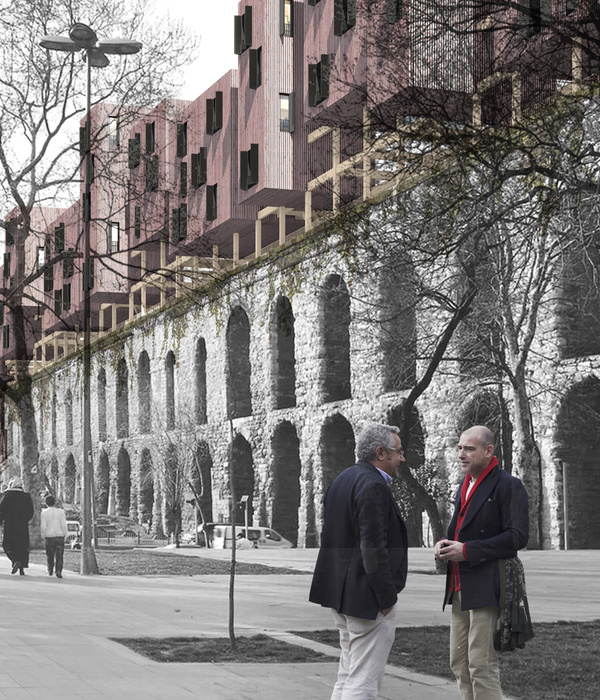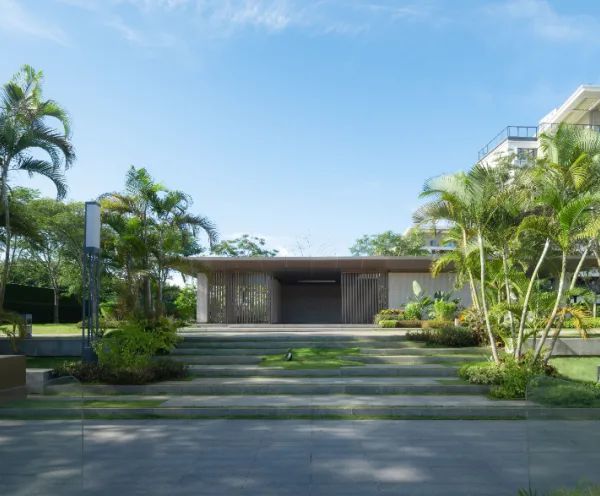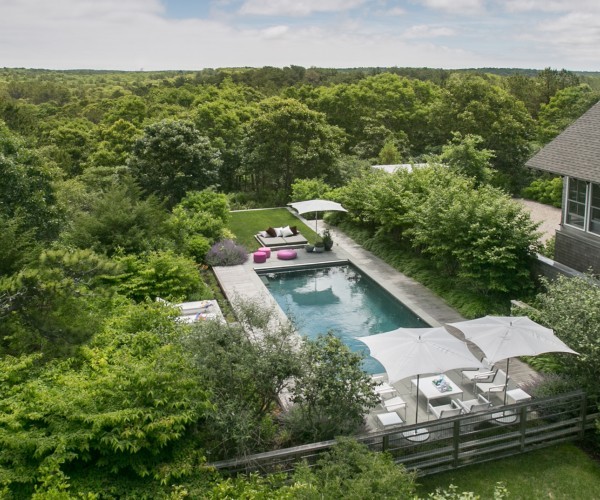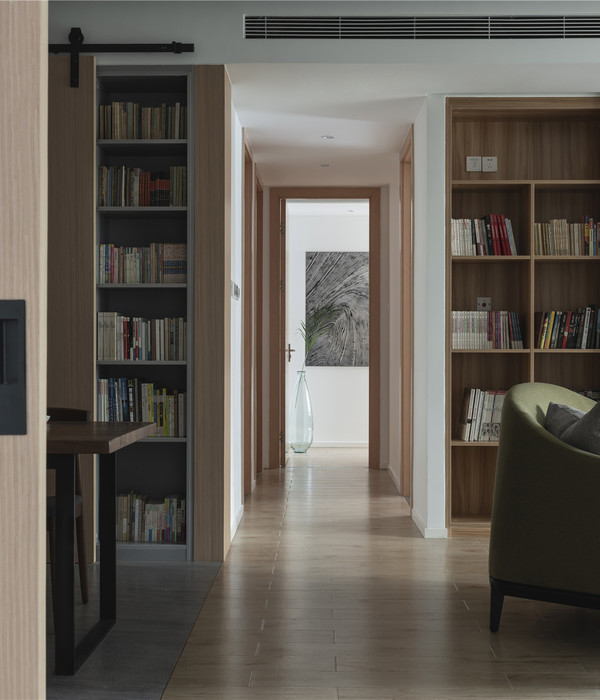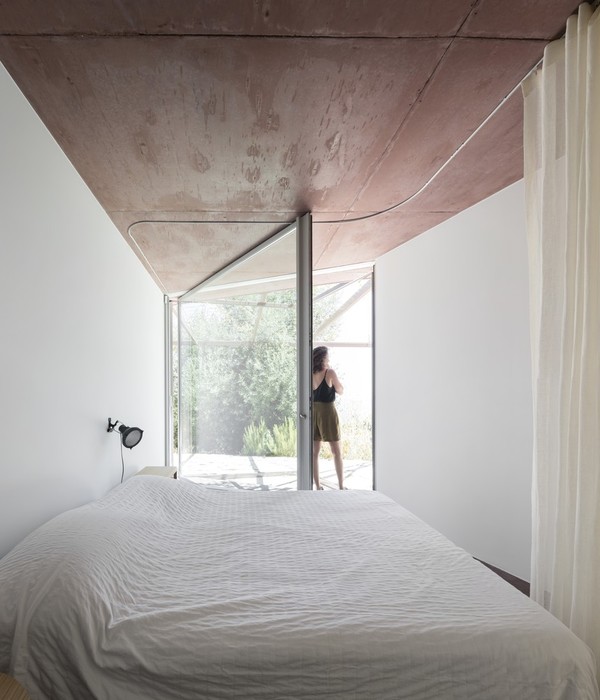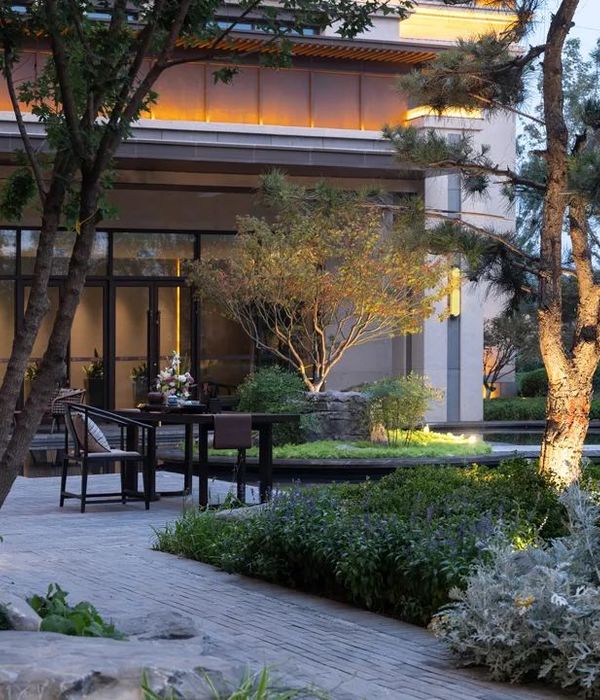项目位于杭州市富阳区的阳陂湖湿地公园,阳陂湖在很早的时候就是一片天然的湖泊,上世纪八十年代被填湖造田,变成了水稻研究所的研究基地,近些年随着城市发展观念的变化,政府希望有更多的自然生态环境被还原,给城市提供可呼吸的窗口,也为城市周边的居民带来免费开放的湿地公园。在项目施工之时就有很多珍稀的鸟类在此栖居,现在更是随处可见白鹭停留于绿岛之上。
▼视频,Video
The project is located at Yangbei lake wetland park in Fuyang District, Hangzhou. Before a wetland park, Yangbei lake used to be a natural lake, empoldered into an experimental paddy field for rice cultivation research in the 80s. The environmental impact of this administrative decision was revised after drastic changes in recent urban-development philosophies, which involve the re-naturalization of previously cultivated lands, providing urban areas with breathable intervals, and suburb-living households with accessible nature-themed public spaces. Various rare birds can be easily spotted within the park’s perimeter during the project’s construction. The sight is even more prominent now, with egret seen throughout the islands in the park.
Bird-Eye view of the site
区位环境
Position
政府委托我们设计的时候,整个湖区的景观都已经在施工,给我们的时间非常紧张,需要在三个月把房子建造好投入使用,极不充分的时间对我们来说是很大的挑战,好在跟我们合作的施工方非常给力,合理的安排施工过程和周期,一起配合完成了这个艰巨的任务。
接待中心位于阳陂湖湿地公园南侧停车场附近,靠近富阳市中心,人流量较为集中,有很强的集散和接待性功能,建筑里面需要配套接待、咨询、售票、管理、办公、医务室、同时具备洗手间、母婴室、水饮售卖、休息等功能。虽然面积不大,但是功能的复合型很强。附近也设有游船和观光小火车停靠点,是阳陂湖湿地公园的重要集散地点和接待中心。
▼接待中心位于阳陂湖湿地南侧,The reception center relative to the wetland part
When the government assigned the project, the construction of the general park area had already started, resulting in an extremely tight time frame of three months. This inadequate time budget imposed a severe challenge for us. Luckily, we successfully solved the hurdle with our construction partner’s effective building planning and project timing.
The reception center is located near the south Parking lot of the wetland park, at the side close to the downtown area of Fuyang District. With its close proximity to the city’s center of human and potentially tourist traffic, the reception center is expected to fulfill the demanding role of visitor accommodation. The relatively compact building needs to provide a variety of functions, including visitor reception, information booth, ticketing, management, office space, and medical services. Visitor amenities like restrooms, nursing rooms, vending facilities, and resting areas are also expected to be incorporated by the design. Once constructed, together with the nearby sight-seen train station and pedal boat dock, the building will serve as a vital tourist traffic node for Yangbei lake wetland park, facilitating visitors’ needs.
西侧残疾人入口,West-side accessible entrance
设计灵感
Design Inspiration
这是我思考的第一个问题,脑子直接蹦出的一个想法就是用装配式建造,这几年事务所也一直有在研究小型的轻型装配式建筑,刚好在这个项目中进行实践,最关键的是有专业的施工团队和厂家能够跟我们一起深化结构计算,构件连接,建造工序,解决这些技术难题,使得项目本身变得没那么大压力,同时又能保证建造品质,这种轻型的建造方式可以实现对土地最小的破坏,不但建造速度快而且更生态环保。
"How to complete the construction in such a narrow time budget" is the first problem that came to my mind. The solution that came right after is to utilize modularized construction. Our design firm has been devoted to the research of modularized construction for compact structures; this project provided a perfect test ground for applying this novel building method. It took more than one firm’s effort to realize this vision: our construction partner and material supplier worked with us closely to ensure the structure’s integrity and stop technical hurdles like stress model computation, segment connection, and construction procedure design from affecting the project’s progress. Speed was not the only advantage of this construction method, as it also reduces environmental impact, keeping the damage to the land during the construction at minimal.
▼场地鸟瞰,Site overview
这是第二个问题,第一次来项目地的时候,就留意到有很多白鹭停留在绿岛上,这种场景就给我留下了深刻的印象,那么第二个问题就解决了,我们就做一个像鸟儿栖息在绿岛上一个房子吧,建筑的形态上设计一个大的出檐屋顶,似鸟类的羽翼,呈折翅状,左右一高一低,以低矮的形态,伏在绿地上,就像鸟儿栖息在那里。
▼设计策略,Design strategy
"What characteristics should a construct near a wetland has" is the second problem needed to be solved. A significant egret presence on the green island of the lake profoundly impacted me during our very first visit to the site. The scene, therefore, solved the second problem — we decided to construct the house that matches the silhouette of a bird inhabiting on the island. Two sizable roofs with asymmetrical heights and overhanging eaves resemble the wings of a bird. The house has a low and horizontally-extending contour resting on the green field, just like a bird settling down in its nest.
Two folded roof warping upward, resembling wings
傍晚的接待中心,Reception center at dusk
这是第三个问题,首先对各个功能空间进行组织与分块,建筑实体部分分成三个体量,女卫、热水、售卖一个体块,男卫、残卫、母婴一个体块,另外接待售票,办公医务一个体块,卫生间为实体,靠近停车场区域,接待为虚体,靠近湿地湖区和公共交通停泊点,三个体量错位分布,虚实结合。同时在两个大屋顶下让出灰空间,形成入口、休息区及庭院,建筑可以很自由的从各个檐下空间进入,也可以在下雨的时候到屋顶下躲雨。
How to incorporate so many features into one compact building is the third problem that the design has to answer. To solve it, we have to divide the building into three segments based on their functions. The first segment consolidates the female restroom, hot water outlet, and vending facilities; the male restroom, unisex and accessible restroom, and the nursing room form the second segment; the third segment includes the ticket vendor, office spaces, and medical room. Toilets utilize solid spacings and are made accessible by locating them near the Parking lot. The reception block employs vague and suggestive boundaries and directly leads to the lake area and the park transit hub. Three segments complement each other with their distinctive feature sets. They also granted a gray area under the roof, forming entrances from multiple directions, a resting space, and a patio. The result is a building that can be easily accessed from all sides and can provide shelter under its spacious roof.
剖透视图,Sectional perspective
▼从铁轨看向接待中心,The reception center looking from the rail tracks
▼一虚一实的体量关系,Vague boundaries compliment with vivid spacings
▼围绕树院的灰空间
Gray space surrounding the tree yard
▼园丁在大屋顶下休憩,Gardeners resting under roof’s shelter
▼南侧屋顶下的灰空间,Gray space under the south side roof
卫生间室内,Lavatory interior
两月建造日记
The Two Month Construction Journal
整个项目只用了两个月就完成了从无到有的建造,建造速度很快,工序流程清晰,设计施工同步推进,经验和用心作用巨大,团队的力量非常重要。
We finished the construction of the project from scratch within two months. This incredible efficiency results from valuable experiences, attention to detail, and, most importantly, teamwork, which allows a well-planned building procedure and synchronizes the design process with on-site construction.
▼施工流程,Construction procedure
2020.8.7开始施工后第一次到现场,工人正在用在现场大型吊机吊装厂里加工好的梁柱。基础梁架搭建了一半,现场还有很多螺丝桩准备打下去。
2020.8.13一周后再到现场,地上摆放了很多轻钢龙骨墙体准备安装。屋架已经做好了大半,加工好的胶合木梁也运输到现场,做好了防护,准备等屋架做好就安装上去。纯室内部分的地面已经浇好了混凝土,做好了找平。
2020.8.18从远处看到房子已经有了框架形状,屋顶的形态已经出来,胶合木梁已经全部安装完成。建筑的空间形态和主结构已经完成,准备安装屋顶望板。把屋顶的防水做好后,室内的工程就可以全面开动,不用担心下雨的问题。
2020.8.22现场正在安装外墙的轻钢龙骨墙体。屋顶的望板已经安装完成,屋顶上需要预埋的灯光走线点位也已全部预留。
2020.9.1工人正在室内安装空调设备,墙体里预埋了室内水电线管。室外墙体的基层封板和防水已完成,基层龙骨固定完成,准备安装外墙的木板材。屋顶钢梁基层用刨花板包好,准备包胶合木花旗松板。
▼现场建造记录,On-site construction record
Aug. 7th, 2020: First site visit since the start of the construction. Heavy-duty cranes are installing structural beams. Building’s basic structure is half-finished, with more screw piles need to be installed. Construction workers are fitting pre-fabricated structural beams on the site.
Aug. 13th, 2020: One week since the first visit. Lightweight steel-framed walls are lying on the site and ready to be installed. Laminated wooden beams have also arrived at the site with adequate protection. They will be installed on the roof keel once it completes. Concrete placement of interior floors is finished with leveling.
Aug. 18th, 2020: The house’s silhouette looks distinguished from a distance. With all laminated wooden beams in place, the roofline also starts to take shape. The primary supporting structure is mostly finished. Construction workers are preparing to install roof plates. Waterproofing is essential for the next step. Once the roof plate is in place, the interior construction will start without any concerns about the weather.
Aug. 22nd, 2020: Workers proceed with the installation of external lightweight steel-framed walls. Roof panels are in place, with wiring spaces for roof lightings reserved.
Sept. 1st, 2020: Workers start to install interior air-conditioning devices. All walls have water pipes and electrical wires embedded, and their exterior base sealing and waterproofing are also completed. The basal keel is fastened in position. The next step will be installing external wooden decor plates. Roof steel beams are coated with chipboards, they will be attached with Douglas fir plates later.
▼结构分解示意图,Structure composition
2020.9.8 外墙木板已安装完成,屋顶的保温防水层已经做好,正在安装用花旗松定制的实木门窗。设计统一了屋顶面和门窗套的颜色,三个体量中一个公共开放体量外墙用原木色板材,卫生间体量用黑色碳化板材,示意出不同的公共属性。室内墙面、地面、照明、空调、洁具全面安装。
▼出挑的大屋檐下 ,Space under the overhanging eave
金属屋面,Metal roofing
2020.9.13 到现场时挖机正在整理周边的土地。铝镁锰屋面板已经上屋面准备安装,门窗正在安装。外墙面基本施工完成,地面在铺装户外竹胶地板,已可见建筑形态和大致效果。
2020.9.21 玻璃安装完成,工人正在调试建筑的细节收边,并修改完善局部。周边景观道路在做硬化,土坡做平整。
2020.9.27 到现场调试室内灯光亮度角度,检查室外灯带平整度。要求增加了屋顶顺水雨链细节。室内进行打胶勾缝,以及设备调试。至此,整个建筑到室内的建造在两个月不到的时间内完成。
Sept. 13th, 2020: Excavators are consolidating surrounding land areas when we arrive at the site. Al-Mg-Mn alloy roof tiles have been moved to the rooftop and are ready for installation; meanwhile, doors and windows are being fitted to their frames. Exterior finishes are almost completed, except the outdoor floor area is still undergoing laminated bamboo floor fitting. The general visual presence of the building has become increasingly distinguishable.
Sept. 21st, 2020: Workers have finished the glass fitting; they are now meticulously adjusting the building’s details, fixing minute problems that went unnoticed during previous construction. We also see progress in surrounding environments adjustment with parkways hardened, and landscapes leveled.
Sept. 27th, 2020: Before completion, we conducted our final refinement. We tuned the intensity as well as the direction of interior lighting on site. External light strips also received close inspections to prevent uneven installation. We also added a rain chain to the roof. The final step is to conduct Interior caulking and equipment testing. We finally finished the project within two months’ time.
▼屋顶交接处的灰空间
Gray space under roofs’ intersection
▼树穿过屋面细部,Details of the tree passing through the roof
▼上下叠合的屋顶,Overlaying roof
▼木结构与钢梁连接细节,Details of wooden structures joints with metal structural beams
值得一提的是整个建筑没有用一块砖,全部是轻质做法,工厂预制现场安装,除了地面基层的混凝土现浇和贴水磨石砖,其他都是无水工程,用板材轻钢重钢胶合木这些构件化材料组装。
It is worth noticing that not a single brick was used during the whole construction — everything was done through modularized lightweight parts pre-fabricated in factories. Via the nature of the modularized construction method incorporating light/heavy steel parts and laminated wooden panels, besides the concrete base and the terrazzo tile application, the rest of the construction process did not require any water-activated adhesive.
▼出檐木结构屋顶细节,Details of the roof with overhanging eaves
▼大屋顶下的院子,The patio under the roof
思考Retrospects
在阳陂湖湿地项目中选择运用了装配式的检验方式,出于三方面考虑:首先是建造速度的需要,普通框架结构建造方式周期较长,建造工序复杂,很难控制周期,而装配式建筑属于可移动的轻型建筑,采用工厂预制现场架构,就很方便,用地性质不受限,建造工序流程清晰,施工工艺好把握,施工管理方便,精准度相对提高,关键大幅提升了建造速度。
大出挑的屋檐,Eave with significant overhanging area
▼墙身详图,Wall structure details
其次是对环境的可持续的考量,用地性质的回应,常规的建造方式在施工时对土地破坏较大,建筑拆除时耗费人力物力,而装配式建筑架空的形式不破坏土地,建筑拆走之后马上可以复绿,拆下来的材料也可以被二次利用,也可以被重装二次建造。
The second reason is modular construction’s minimal environmental impact. Conventional construction methods inevitably involve tremendous destructions of the land area within projects’ close proximity; structures built with such method also require significant labor and capital to demolish. With modularized structure comes with none of those issues: being built on stilts, modularized buildings would not impose permanent land damage. After the removal of a modular structure, the land it used to sit on can be reseeded instantaneously, while the parts collected from the disassembling can be recycled or reconstructed as is.
▼从停车看向接待中心,The reception center from Parking lot
西侧建筑立面,Facade of the building from the west side
最后是对传统建筑智慧的提取,与中国的传统木构建筑的呼应不仅仅是在形式上,也在于建造的内部逻辑上。中国传统木构建筑的精髓就在于的装配式概念,所有独立的构件都用隼卯的方式连接,可拆装重组,可更换翻新,可修复迁移,属于最纯粹的最早的最灵活的装配式建筑,包括木构建筑外围砖瓦材料,同样都是可以非常轻便的单元式构件材料,可以被组织被重构被二次利用。建筑与大地的连接方式也是轻巧的,直接是放置在大地上,房子被拆除之后,原来的宅基地就可以直接变成自然地,耕种作物,这都是中国传统文化中最高级的智慧。
The last reason of the three is the treasuring of classic architectural wisdom. Modular construction resembles the construction of traditional Chinese wooden constructs not only in its procedure but also in its core philosophy. Modularity and cement-free construction are the essences of Traditional Chinese wooden structures; all individual components are interlinked with tenon joints, allowing them to be disassembled and reassembled. Structural parts can be replaced, renewed, or removed — the Chinese wooden constructs are some of the earliest iterations of versatile modular buildings. The versatility does not end at the structural parts, as exterior components such as roof tiles and bricks are also highly maneuverable and easy to transport building units that can be easily regrouped and utilized elsewhere. The way traditional wooden structures connect with the ground is also non-intrusive and non-destructive, as the houses are placed on the surface. After the house has been removed, the basis of the construct can easily be transformed back to its natural state or be converted into a farm field. The modularity in building construction represents the ancient wisdom passed on through generations from China’s glorious history.
Bird-Eye view in dawn
▼两片大屋顶,Two pieces of roof
▼手工模型,Manual model
▼总平面图,Site plan
▼平面图,Floor plan
▼南立面图,South elevation view
▼东立面图,East elevation view
项目名称:富阳·阳陂湖湿地公园南接待中心
项目地点:杭州市富阳区阳陂湖湿地公园
项目业主:杭州富春山居集团有限公司
施工单位:杭州中普建筑科技有限公司
设计单位:尌林建筑设计事务所
项目类型:配套接待类·公共建筑
设计时间:2020.7-2020.8
建造时间:2020.8-2020.10
设计单位:尌林建筑设计事务所
主持建筑师:陈林、刘东英
参与设计师:陈伊妮、王嘉欣、崔佳伟(实习)、黄伟斌(实习)结构形式:钢木结构轻钢装配
建筑材料:花旗松胶合木、炭化木烧杉板、铝镁锰板、竹木地板、轻钢墙体、水磨石
建筑面积:300㎡
建筑摄影:嵒建筑-赵赛、赵奕龙
Project Name: Fuyang, Yangbei Lake Wetland Park North Reception Center
Project Location: Yangbei Lake Wetland Park, Fuyang,Hangzhou, Zhejiang Province
Project Owner: Hangzhou Fuchunshanju Group Co., Ltd
Construction Constractor: Hangzhou Zhongpu Construction Technology Group Co., Ltd
Design Agency: Shulin Architectural Design
Company Site:Project Type: Supporting Reception, Public Building
Design Period: Jul. 2020 – Aug. 2020
Construction Period: Aug. 2020 – Oct. 2020
Design Agency: Shulin Architectural Design
Lead Architect: Lin Chen, Dongying Liu
Architectural design: Yini Chen, Jiaxing Wang, Jiawei Cui (Intern), Weibin Huang (Intern)Structural Type: Steel-wood structure, lightweight assembly
Construction Materials: Douglas fir Laminated Timber, Burned fir, Al-Mg-Mn Alloy Sheeting, Bamboo and Wood Floor, Light Steel Wall, Terrazzo
Construction Area: 300㎡
Photography: Sai Zhao (Yan Architecture), Yilong Zhao
{{item.text_origin}}


